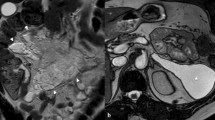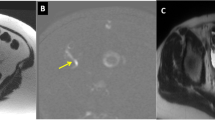Abstract
In order to evaluate the contribution of retrograde air insufflation in decreasing the occurrence of pseudotumor appearance and mimicked lymphadenopathy due to nonair-distended bowel loops, we retrospectively compared two groups of magnetic resonance (MR) examinations. In the group receiving retrograde air insufflation, 10.8% (67 of 619) of images showed a tumor-like lesion due to nonair-distended bowel loop(s), whereas in the group not receiving air introduction, a tumor-like lesion was simulated in 45.6% (140 of 307) of images. Furthermore, a collapsed bowel loop(s) mimicking an enlarged lymph node close to the aorta, inferior vena cava, or bilateral iliac vessels was found in 9.5% (24 of 252) of images of the latter group, in contrast to only 1.8% (9 of 505) of images of the former group. This study shows that retrograde air insufflation greatly reduces the occurrence of pseudotumor appearance and false impression of paraaortic, paracaval, or parailiac lymphadenopathy secondary to nonair-distended bowel loop(s).
Similar content being viewed by others
References
Laniado M, Kornmesser W, Hamm B, Clauss W, Weinmann HJ, Felix R. MR imaging of the gastrointestinal tract: value of GdDTPA. AJR 1988;150:817–821
Wesbey GE, Brasch R, Engelstad B, Moss AA, Crooks LE, Brito A. Nuclear magnetic resonance contrast enhancement study of the gastrointestinal tract of rats and a human volunteer using non-toxic oral iron solutions. Radiology 1983;149:175–180
Ballinger R, Magin R, Webb A. Sucrose polyester: a new oral contrast agent for MRI. Magn Reson Med 1991;19:199–202
Lonnemark M, Hemmingsson A, Bach-Gansmo T, et al. Effect of superparamagnetic particles as oral contrast medium at magnetic resonance imaging. Acta Radiol 1989;30:193–196
Ros PR, Steinman RM, Torres GM, et al. The value of barium as a gastrointestinal contrast agent in MR imaging: a comparison study in normal volunteers. AJR 1991;157:761–767
Mitchell DG, Vinitski S, Mohamed FB, Mammone JF, Haidet K, Rifkin MD. Comparison of Kaopectate with barium for negative and positive enteric contrast at MR imaging. Radiology 1991;181:475–480
Mattrey R. Perfluorooctylbromide: a new contrast agent for CT, sonography and MR imaging. AJR 1989;152:247–252
Chou C-K, Liu G-C, Yang C-W, Chen L-T, Sheu R-S, Jaw T-S. Abdominal MR imaging following antegrade air introduction into the intestinal loops. Abdom Imaging 1993;18:205–210
Chou C-K, Liu G-C, Chen L-T, Jaw T-S. Retrograde air insufflation in MRI: a technical note. Abdom Imaging 1993;18:211–214
Author information
Authors and Affiliations
Rights and permissions
About this article
Cite this article
Chou, C.K., Sheu, R.S., Yang, C.W. et al. Abdominal pseudotumors and simulated lymphadenopathy in MRI: Differential features with the use of retrograde air insufflation. Abdom Imaging 19, 503–506 (1994). https://doi.org/10.1007/BF00198250
Received:
Accepted:
Published:
Issue Date:
DOI: https://doi.org/10.1007/BF00198250




